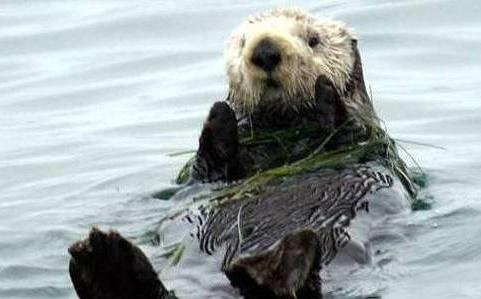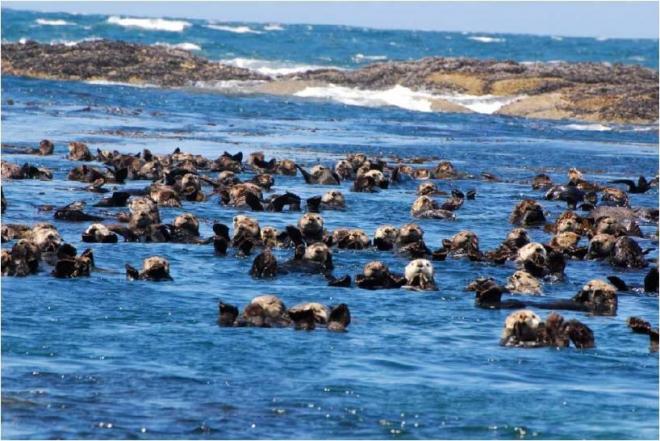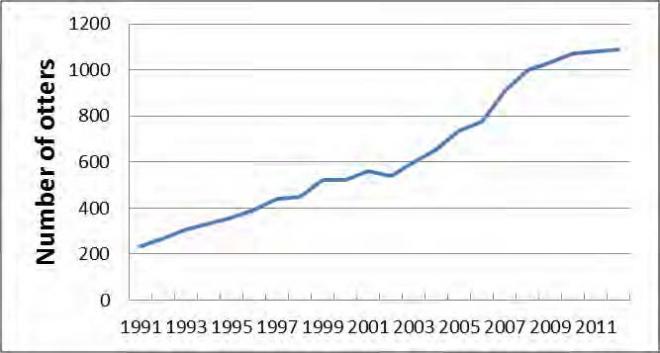Sea Otter (Enhydra lutris)
This article was originally published by the Washington Department of Fish and Wildlife as part of its annual report Threatened and Endangered Wildlife in Washington.
State Status: Endangered, 1981
Federal Status: Species of concern
Recovery Plans: State, 2004
Sea otters are among the largest members of the weasel family, but are the smallest marine mammals in the North Pacific. The species is known for its luxuriantly thick pelage, which is the densest of all mammals. Sea otters inhabit nearshore waters up to 20 fathoms deep and seldom venture more than 1-2 km from land. They typically inhabit rocky habitats with kelp beds, but also occur at lower densities in soft-sediment areas without kelp. Kelp is generally considered an important part of habitat and is used for foraging and resting.
Sea otters capture prey from the sea bottom, then carry it to the surface for handling and feeding. A variety of prey is eaten, especially in areas inhabited for long periods. In recently occupied areas, sea otters tend to exhaust one type of food (e.g., sea urchins, various crustaceans, or mollusks) before switching to another (Estes et al. 1982, Riedman and Estes 1990, Laidre and Jameson 2006). In Washington, prey include urchins, clams, mussels, crabs, snails, and chitons (Bowlby et al. 1988, Laidre and Jameson 2006). Predation on urchins gives sea otters a fundamental role in maintaining the structure of nearshore marine ecosystems in many areas (Estes and Duggins 1995, Kvitek et al. 1998). Removal of urchins promotes the growth of kelp and kelp-associated communities.
The species once lived along most of the North Pacific coasts from California to Japan, but was extirpated from most of its range by the early 1900s by the fur trade (Kenyon 1969). In Washington, sea otters historically occurred in estuarine and sandy habitats from the Columbia River to Pt. Grenville, along the rocky outer Olympic Peninsula coast, and into the Strait of Juan de Fuca, but with few reaching the San Juan Islands and Discovery Bay, and none present in Puget Sound (Scheffer 1940, Kenyon 1969). The species was extirpated from the state by about 1910 (Scheffer 1940, Kenyon 1969).
Sea otters were reintroduced to Washington in 1969 and 1970, when 59 animals were translocated from Amchitka Island, Alaska (Lance et al. 2004). The population has grown by 7.6% per year since 1991 to 1,105 animals in 2012 (Jameson and Jeffries 2013). However, overall population growth has slowed since 2008 and the northern population segment may be reaching carrying capacity. At present, otters occur primarily in rocky habitats along the Olympic Peninsula coast from Destruction Island northward to Tatoosh Island. Colonization of the western Strait of Juan de Fuca has not yet occurred despite the presence of groups of animals using the area during fall and winter months until 2000 (Laidre et al. 2009). A state recovery plan for the otter was written in 2004 (Lance et al. 2004).
Sea otters in Washington face a number of potential threats (Lance et al. 2004). These include oil spills, contaminants, disease, marine biotoxins, entanglement in fishing nets, loss of kelp habitat, and reduced genetic diversity.
Monitoring. Washington’s sea otter population is surveyed annually in July through a combination of aerial and ground counts along the entire outer coast and eastward into the Strait of Juan de Fuca to Tongue Point. The 2012 survey was made on 9-13 July and produced a total count of 1,105 sea otters (Figure 3; Jameson and Jeffries 2013). A high of 29 pups was counted, with a pup to independent otter ratio of 2.7:100. The single largest concentration (562) of sea otters was at Destruction Island. The southernmost otters were observed near Cape Elizabeth and Willoughby Rock and the northernmost otters were seen at Tatoosh Island. No otters were sighted in the Strait of Juan de Fuca. The distribution pattern of Washington’s sea otter population has gradually changed in recent years with an increasing and larger proportion of the population now occurring south of La Push. In 2012, 73% of the population was south of La Push and 27% was north.
Annual surveys do not extend east of Tongue Point, although credible sightings of scattered individual sea otters have come from the San Juan Islands and Puget Sound in recent years.
No groups of multiple animals have been noted in these areas, thus the small number of sea otters in this region does not add significantly to the state’s total population. In 2012, one individual was reported in south Puget Sound.
Strandings. A total of 32 sea otter strandings occurred in Washington in 2012, with 19 of these reported from south of LaPush and 13 north of LaPush. Necropsies were performed on 15 of the 18 recovered otters by the U.S. Fish and Wildlife Service’s National Wildlife Health Center in Madison, Wisconsin, and by WDFW’s Lakewood office.
Oil spill prevention and response. State and federal agencies, industry, tribes, and other stakeholders continue efforts to protect Washington’s natural resources (including sea otters) from oil spills. Response planning and participation in oil spill drills are ongoing. In 2010, a rescue tug was permanently deployed at Neah Bay with funding provided by the commercial shipping industry as required by a recent state law. Presence of the tug greatly reduces the threat of oil spills throughout the sea otter’s current range in Washington. An oil spill response handbook specific to seas otters provides guidance on the preferred methods for locating, recovering, and rehabilitating sea otters injured by contact with oil during an oil spill (WDFW 2009).
Partners and cooperators: U.S. Fish and Wildlife Service, Olympic Coast National Marine Sanctuary, Makah Tribal Fisheries, Quinault Indian Nation, The Seattle Aquarium, Point Defiance Zoo and Aquarium.
Literature Cited
Bowlby, C. E., B. L. Troutman, and S. J. Jeffries. 1988. Sea otters in Washington: distribution, abundance, and activity patterns. Final report prepared for National Coastal Resources Research and Development Institute, Hatfield Marine Science Center, Newport, Oregon.
Estes, J. A. and D. O. Duggins. 1995. Sea otters and kelp forests in Alaska: generality and variation in a community ecological paradigm. Ecological Monographs 65:75-100.
Estes, J. A., R J. Jameson, and E. B. Rhode. 1982. Activity and prey selection in the sea otter: influence of population status on community structure. American Naturalist 120:242-258.
Jameson, R. J. and S. Jeffries. 2013. Results of the 2012 survey of the reintroduced sea otter population in Washington state. Washington Department of Fish and Wildlife, Lakewood, Washington.
Kenyon, K. W. 1969. The sea otter in the eastern Pacific Ocean. North American Fauna 68:1-352.
Kvitek, R. G., P. J. Iampietro, and C. E. Bowlby. 1998. Sea otters and benthic prey communities: a direct test of the sea otter as keystone predator in Washington state. Marine Mammal Science 14:895-902.
Laidre, K. L. and R. J. Jameson. 2006. Foraging patterns and prey selection in an increasing and expanding sea otter population. Journal of Mammalogy 87:799–807.
Laidre, K. L., R. J. Jameson, E. Gurarie, S. J. Jeffries, and H. Allen. 2009. Spatial habitat use patterns of sea otters in coastal Washington. Journal of Mammalogy 90:906-917.
Lance, M. M., S. Richardson, and H. Allen. 2004. Washington state recovery plan for the sea otter. Washington Department of Fish and Wildlife, Olympia, Washington.
Riedman, M. L. and J. A. Estes. 1990. The sea otter (Enhydra lutris): behavior, ecology, and natural history. U.S. Fish and Wildlife Service Biological Report 90(14):1-126.
Scheffer, V. B. 1940. The sea otter on the Washington coast. Pacific Northwest Quarterly 10:370-388. WDFW (Washington Department of Fish and Wildlife). 2009. Oiled sea otter response handbook. Washington Department of Fish and Wildlife, Olympia, Washington. 66 pp.
Source: Washington Department of Fish and Wildlife. 2013. Threatened and Endangered Wildlife in Washington: 2012 Annual Report. Listing and Recovery Section, Wildlife Program, Washington Department of Fish and Wildlife, Olympia. 251 pp.








